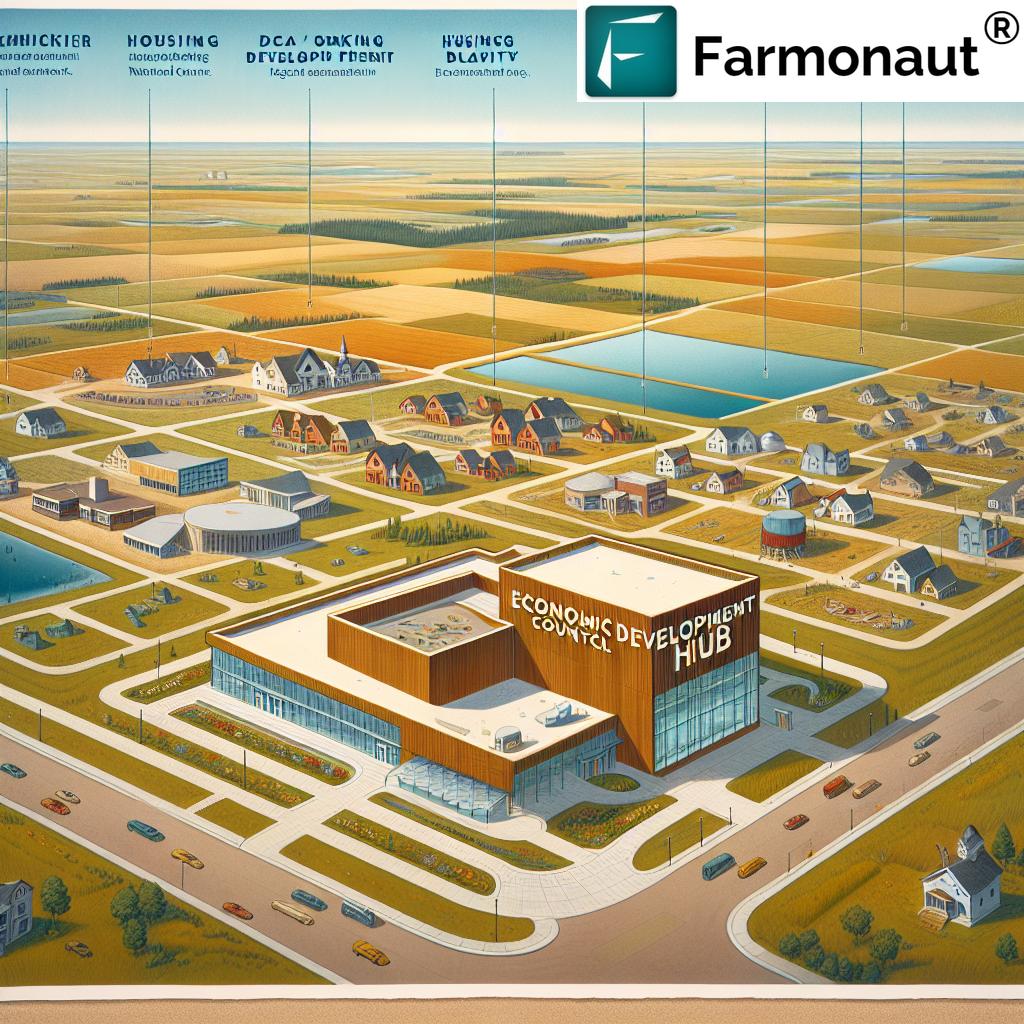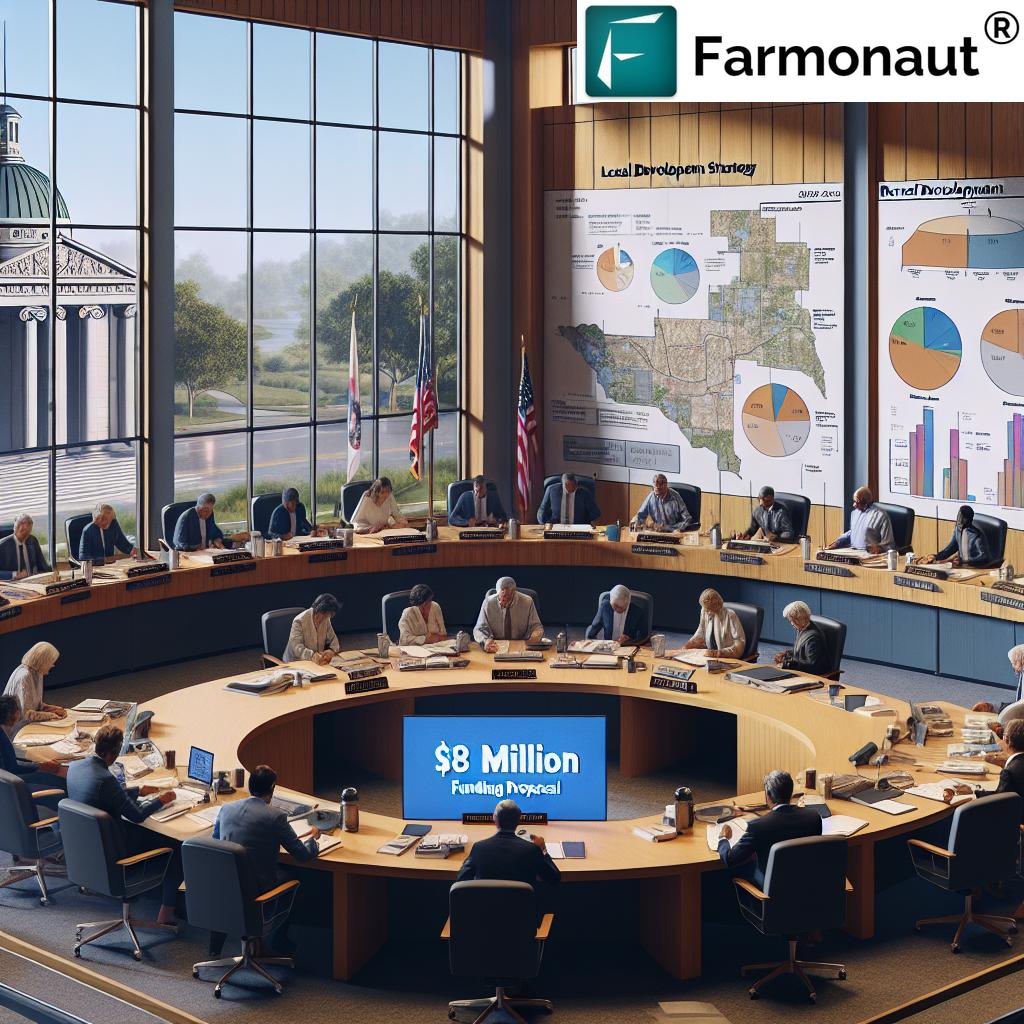North Dakota’s Economic Boost: $8 Million Proposed for Regional Councils to Drive Rural Development
“North Dakota’s proposed $8 million funding boost could impact 8 regional planning councils, enhancing rural economic growth initiatives.”
In a significant move towards bolstering rural economic development, North Dakota is poised to inject new life into its regional councils. We’re witnessing a pivotal moment in the state’s approach to community support and economic growth, particularly in rural areas. The proposed allocation of $8 million to the North Dakota Department of Commerce marks a watershed moment for the state’s eight regional planning councils, promising to reshape the landscape of rural development initiatives.
As we delve into this exciting development, let’s explore how this funding proposal could transform North Dakota’s economic landscape and community development strategies. From addressing critical needs in housing and daycare to fostering new business opportunities, the impact of this initiative promises to be far-reaching.
Understanding the Proposal: A Closer Look at House Bill 1524
On February 4, 2024, North Dakota Representative David Monson took center stage to advocate for House Bill 1524. This groundbreaking legislation aims to allocate $8 million to the North Dakota Department of Commerce, earmarked specifically to support the state’s eight regional planning councils during the upcoming biennium from July 2025 to June 2027.
Monson, a Republican from Osnabrock and one of the bill’s sponsors, emphasized the crucial role these councils play in economic and community development across North Dakota. Notably, he pointed out that these vital organizations have not received state funding previously, making this proposal all the more significant.

Breaking Down the Funding Allocation
The proposed funding structure is designed to ensure equitable distribution while allowing for targeted support based on specific regional needs. Here’s how the $8 million would be divided:
- Base Funding: Each of the eight regional councils would receive an equal share of $500,000, totaling $4 million.
- Targeted Allocation: The remaining $4 million would be distributed based on a formula developed by the Department of Commerce and the association of regional councils.
This balanced approach ensures that each council has a solid foundation of support while allowing for additional resources to be allocated based on specific regional challenges and opportunities.
The Vital Role of Regional Councils in North Dakota’s Development
Regional councils serve as the backbone of local economic development efforts across North Dakota. These organizations play a multifaceted role in addressing critical community needs:
- Housing development and affordability initiatives
- Daycare and childcare support programs
- Workforce development and retention strategies
- Business opportunity creation and entrepreneurship support
- Infrastructure planning and development
By focusing on these key areas, regional councils act as catalysts for growth, helping to create vibrant, sustainable communities across the state.
Widespread Support for the Funding Initiative
The proposal has garnered significant backing from various sectors, highlighting the widespread recognition of the importance of regional councils in North Dakota’s economic ecosystem. During the legislative hearing:
- 11 individuals provided oral testimonies in support of the bill
- Over 50 written testimonies were submitted from across the state
- Supporters included members of regional councils, agricultural organizations, and business leaders
This overwhelming show of support underscores the critical role these councils play in leveraging investments for local communities and driving economic growth.
Tangible Impacts: Regional Councils’ Achievements (2019-2023)
To understand the potential impact of this funding boost, let’s look at what regional councils have already accomplished between 2019 and 2023:
- Created or retained over 5,000 jobs across the state
- Facilitated numerous public forums to address community needs
- Developed comprehensive community and economic strategies
- Leveraged nearly $900 million in investment for North Dakota
These achievements demonstrate the councils’ ability to drive significant economic impact, even with limited resources. The proposed funding aims to amplify these successes and expand their reach across rural North Dakota.

Addressing Rural Challenges: The Role of Regional Councils
Rural communities in North Dakota face unique challenges, particularly in accessing and managing state and federal resources. Regional councils play a crucial role in bridging this gap:
- Administrative Support: Many small towns lack the administrative capacity to navigate complex grant processes effectively.
- Grant Access: Councils help communities tap into available funding sources for vital projects.
- Project Management: By providing expertise in project planning and execution, councils ensure that rural initiatives come to fruition.
The proposed funding would significantly enhance the councils’ ability to provide these essential services, ensuring that rural communities can fully leverage available resources for growth and development.
Enhancing Capacity: Staffing and Resource Allocation
One of the key benefits of the proposed funding is the ability to enhance the capacity of regional councils. Currently, most councils operate with minimal staff—typically around three employees per council. This limited workforce strains their ability to meet the increasing demands in areas such as:
- Economic development initiatives
- Workforce enhancement programs
- Infrastructure support projects
The additional funding would allow councils to hire and retain staff essential for assisting local communities in accessing available grants and funds for projects. This increased capacity is crucial for maximizing the impact of state and federal resources in rural areas.
Addressing Funding Cycle Challenges
Dawn Mandt, executive director of the Red River Regional Council, highlighted a significant issue within current funding models: the reliance on short-term grants to sustain long-term projects. This approach is often unsustainable and can lead to interruptions in critical community initiatives.
The proposed state funding aims to provide a more stable financial foundation for regional councils, allowing for:
- Continuous support for long-term projects
- Improved planning and resource allocation
- Enhanced ability to leverage additional funding sources
By addressing these funding cycle challenges, regional councils can provide more consistent and effective support to the communities they serve.
“The $8 million allocation to North Dakota’s Department of Commerce aims to address local needs in housing, daycare, and business opportunities.”
Agricultural Sector Support: A Key Focus
North Dakota’s agricultural sector stands to benefit significantly from the proposed funding for regional councils. Representatives from organizations such as the ND Farmers Union and the ND Soybean Growers Association have voiced strong support for the bill, recognizing the critical role regional councils play in supporting local agricultural initiatives.
Key areas of support for the agricultural sector include:
- Facilitating access to rural development grants
- Supporting farm-to-table initiatives and local food systems
- Assisting with agricultural infrastructure projects
- Promoting agri-tourism and diversification opportunities
By strengthening regional councils, North Dakota is investing in the future of its agricultural communities, ensuring they have the resources and support needed to thrive in a changing economic landscape.
Connecting Communities with State and Federal Programs
Melissa Beach from Minnkota Power Cooperative eloquently articulated the vital role regional councils play as intermediaries between local communities and state and federal programs. This connection is crucial for:
- Identifying relevant funding opportunities
- Navigating complex application processes
- Ensuring compliance with program requirements
- Facilitating project completion and reporting
By strengthening this link, the proposed funding will help ensure that North Dakota’s communities, especially in rural areas, can fully benefit from available resources and programs.
Addressing Workforce Challenges in Rural Areas
One of the most pressing issues facing rural North Dakota is workforce development and retention. Regional councils are uniquely positioned to address these challenges through:
- Tailored workforce training programs
- Partnerships with local educational institutions
- Initiatives to attract and retain young professionals
- Support for remote work opportunities
The proposed funding will enhance the councils’ ability to implement innovative workforce solutions, helping to ensure the long-term vitality of rural communities.
Enhancing Rural Infrastructure and Technology Access
In today’s digital age, access to modern infrastructure and technology is crucial for economic development. Regional councils play a key role in:
- Advocating for broadband expansion in rural areas
- Supporting smart city initiatives in smaller communities
- Facilitating infrastructure improvement projects
- Promoting the adoption of agricultural technology
With increased funding, councils can more effectively drive these initiatives, helping to bridge the digital divide and enhance the competitiveness of rural North Dakota.
North Dakota Regional Council Funding Allocation
| Regional Council Name | Counties Served | Estimated Population Impacted | Proposed Funding Amount | Key Focus Areas |
|---|---|---|---|---|
| Tri-County Regional Development Council | Pembina, Walsh, Nelson | 25,000 | $1,000,000 | Housing, Workforce Development |
| Red River Regional Council | Grand Forks, Traill, Steele | 100,000 | $1,200,000 | Business Opportunities, Infrastructure |
| Lake Agassiz Regional Council | Cass, Richland, Ransom, Sargent | 200,000 | $1,300,000 | Daycare, Economic Development |
| South Central Dakota Regional Council | Barnes, Dickey, Foster, Griggs, LaMoure, Logan, McIntosh, Stutsman, Wells | 75,000 | $1,100,000 | Rural Revitalization, Agriculture |
| Lewis & Clark Regional Development Council | Burleigh, Emmons, Grant, Kidder, McLean, Mercer, Morton, Oliver, Sheridan, Sioux | 150,000 | $1,200,000 | Tourism, Small Business Support |
| Roosevelt-Custer Regional Council | Adams, Billings, Bowman, Dunn, Golden Valley, Hettinger, Slope, Stark | 50,000 | $1,000,000 | Energy Sector, Community Planning |
| Souris Basin Planning Council | Bottineau, Burke, McHenry, Mountrail, Pierce, Renville, Ward | 80,000 | $1,100,000 | Flood Mitigation, Economic Diversification |
| North Central Planning Council | Benson, Cavalier, Eddy, Ramsey, Rolette, Towner | 40,000 | $1,000,000 | Healthcare Access, Youth Retention |
The Role of Technology in Rural Development
As we consider the future of rural development in North Dakota, it’s crucial to recognize the role that technology can play in enhancing agricultural productivity and sustainability. While regional councils focus on broad economic development, innovative agritech solutions can complement these efforts by empowering farmers with data-driven insights.
For instance, platforms like Farmonaut offer satellite-based farm management solutions that can significantly benefit North Dakota’s agricultural sector. These technologies provide:
- Real-time crop health monitoring
- AI-based advisory systems for optimal farm management
- Resource management tools to improve efficiency
- Blockchain-based traceability for supply chain transparency
By integrating such technologies into their development strategies, regional councils can further enhance the competitiveness and sustainability of North Dakota’s rural communities.
For those interested in exploring these technological solutions:
- Access Farmonaut’s web application:

- Explore Farmonaut’s API for developers: Farmonaut API
- Download the mobile apps:


Maximizing Impact: Strategies for Regional Councils
With the potential influx of funding, regional councils have a unique opportunity to maximize their impact on rural development. Here are some strategies they might consider:
- Collaborative Projects: Encourage inter-council collaboration on large-scale projects that benefit multiple regions.
- Innovation Hubs: Establish innovation centers in rural areas to foster entrepreneurship and technology adoption.
- Skills Matching Programs: Develop programs that match local workforce skills with emerging industry needs.
- Sustainable Tourism Initiatives: Promote eco-tourism and agri-tourism to diversify rural economies.
- Digital Literacy Campaigns: Launch initiatives to enhance digital skills in rural communities, supporting both personal and professional growth.
By implementing these strategies, regional councils can create a multiplier effect, amplifying the impact of the proposed funding across North Dakota’s rural landscape.
The Future of Rural North Dakota: A Collaborative Vision
As we look to the future, the proposed $8 million funding for regional councils represents more than just a financial boost—it’s an investment in the collaborative vision for rural North Dakota. This initiative recognizes that sustainable development requires:
- Strong local leadership
- Targeted resource allocation
- Innovative problem-solving approaches
- Cross-sector partnerships
By empowering regional councils, North Dakota is laying the groundwork for a more resilient, diverse, and prosperous rural economy. The success of this initiative could serve as a model for rural development strategies across the United States.
Conclusion: A Turning Point for North Dakota’s Rural Communities
The proposed $8 million funding for North Dakota’s regional councils marks a significant turning point in the state’s approach to rural development. By recognizing and supporting the crucial role these councils play in leveraging investments, creating jobs, and addressing local needs, North Dakota is positioning itself at the forefront of innovative rural economic strategies.
As this initiative moves forward, it holds the promise of:
- Revitalizing rural economies
- Enhancing quality of life in small communities
- Fostering sustainable growth across the state
- Bridging the urban-rural divide
The success of this funding proposal could set a new standard for rural development, not just in North Dakota, but across the nation. As we watch this initiative unfold, it’s clear that the future of North Dakota’s rural communities is brighter than ever.
FAQ Section
Q: What is the main purpose of the proposed $8 million funding for regional councils in North Dakota?
A: The main purpose is to enhance rural economic growth initiatives, support workforce development projects, and address local needs in areas such as housing, daycare, and business opportunities across North Dakota’s rural communities.
Q: How will the $8 million be distributed among the regional councils?
A: Each of the eight regional councils will receive a base funding of $500,000. The remaining funds will be distributed based on a formula developed by the Department of Commerce and the association of regional councils.
Q: What are some of the key achievements of regional councils in North Dakota between 2019 and 2023?
A: Regional councils have created or retained over 5,000 jobs, facilitated public forums, developed community and economic strategies, and leveraged nearly $900 million in investment for North Dakota.
Q: How do regional councils benefit rural communities in North Dakota?
A: Regional councils provide crucial administrative support, help communities access grants, manage projects, and serve as intermediaries between local communities and state/federal programs. They also address challenges in workforce development, infrastructure, and technology access.
Q: What impact could this funding have on North Dakota’s agricultural sector?
A: The funding could support initiatives such as facilitating access to rural development grants, supporting farm-to-table initiatives, assisting with agricultural infrastructure projects, and promoting agri-tourism and diversification opportunities in the agricultural sector.
Earn With Farmonaut: Affiliate Program
Earn 20% recurring commission with Farmonaut’s affiliate program by sharing your promo code and helping farmers save 10%. Onboard 10 Elite farmers monthly to earn a minimum of $148,000 annually—start now and grow your income!















